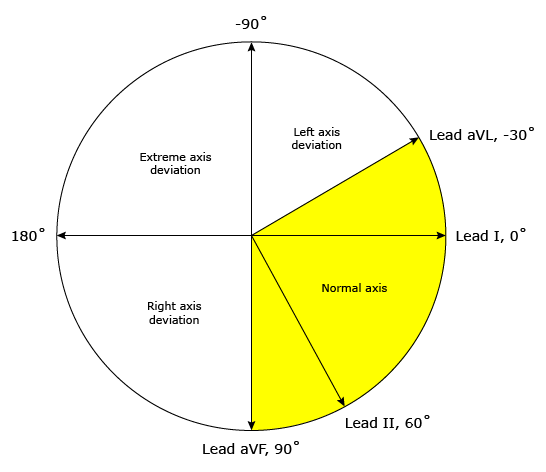다음 것들 중의 하나 이상 존재하는 것은 VT를 아주 많이 시사합니다.
Calculation of frontal plane axis

If the QRS complex is positive in leads I and II, it falls between -30 and 90° and is normal, as indicated by the yellow area. If the QRS complex is negative in I and positive in aVF, there is right axis deviation. If the QRS complex is positive in I and negative in II, there is left axis deviation. If the QRS complex is negative in I and aVF, there is extreme axis deviation.
1. Right superior axis(axis from -90 to ±180 degrees)
때때로 extreme axis deviation, indeterminate axis, "northwest" axis라고 불리며 SVT에서 드물고 VT를 강하게 시사합니다. 이 규칙의 예외는 2개가 있습니다. 첫 번째는 ventricular pre-excitation에서 보이는 antidromic AV reentrant tachycardia (AVRT)입니다. 이 경우에 ventricular myocardium의 탈분극이 정상 His-Purkinje system을 우회하고 QRS complex가 indeterminate axis를 갖습니다. 두 번째는 biventricular pacemaker이며 indeterminate axis, initial Q wave in lead I을 나타냅니다.
2. Shift in axis >40 degrees from a prior baseline
Baseline ECG가 확인 가능한 경우, sinus rhythm의 axis보다 40도 이상 이동한 WCT는 VT를 시사합니다.
3. Specific QRS axis in association with other QRS morphologies
RBBB-like WCT 환자에서 -30 degrees 좌측으로의 QRS axis는 VT를 시사합니다.
LBBB-like WCT 환자에서 +90 degrees 우측으로의 QRS axis는 VT를 시사합니다.
REF. UpToDate 2017.07.09
'심장내과 > 심전도' 카테고리의 다른 글
| Bundle branch reentrant ventricular tachycardia (BBRVT) (0) | 2019.06.23 |
|---|---|
| Wide complex tachycardia(WCT)에서 concordance (0) | 2019.06.23 |
| Monomorphic ventricular tachycardia(VT) (0) | 2019.05.03 |
| 폐성 P, P pulmonale [심전도, EKG(ECG)] (0) | 2019.03.24 |
| 완전 방실 차단(블록),Third degree (complete) AV block (0) | 2019.03.16 |



